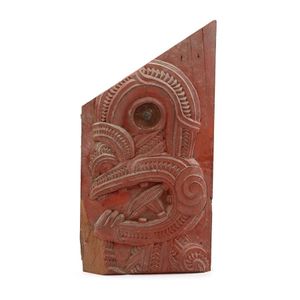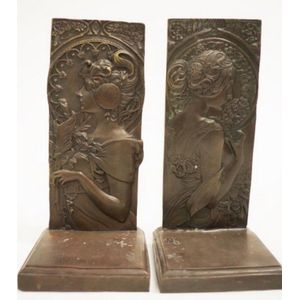Alfonse Mucha Bronze Bookends
You must be a subscriber, and be logged in to view price and dealer details.
Subscribe Now to view actual auction price for this item
When you subscribe, you have the option of setting the currency in which to display prices to $Au, $US, $NZ or Stg.
- Art Nouveau Period - The Art Nouveau period was a cultural movement that emerged in the late 19th century, and was characterized by its emphasis on natural forms, flowing lines, and a decorative, ornamental style. Art Nouveau was a reaction against the ornate and heavily stylized designs of the previous era, and sought to create a new, more organic aesthetic.
Art Nouveau was characterized by its use of sinuous, curving lines, as well as a focus on natural elements such as flowers, vines, and other organic shapes. Art Nouveau designers sought to create a total work of art, in which every element of a building or object was designed to be harmonious with the overall design.
Some of the most iconic examples of Art Nouveau design include the Paris Metro entrances designed by Hector Guimard, the works of the artist Alphonse Mucha, and the architecture of Victor Horta in Brussels.
The Art Nouveau period was at its peak between 1890 and 1910, but began to decline in popularity by the start of World War I. However, Art Nouveau remains an important influence on design and art to this day, and continues to be celebrated for its emphasis on natural forms and decorative style. - Bronze - An alloy of copper and tin, traditionally in the proportions of about 9 parts of copper to 1 part of tin.
The discovery of bronze in Western Asia in the 4th century enabled people to create metal objects which were superior to those previoulsy possible because of its strength and hardness, and it has been used throughout the world for weapons, coins, tools, statuary and other decorative items.
It is very fluid in a molten state, and its hardness, strength when set, and non-corrosive properties makes it most suitable for casting sculpture. - Mucha, Alphonse - Alphonse Mucha (1861 - 1931) was a Czechoslovakian born artist and illustrator who also worked in Paris and the United States. He is best known for his distinctively styled Art Nouveau paintings, illustrations, advertisements and designs.
He also designed jewellery, textiles furniture and smaller decorative items. - Manner of .... / Style of ..... - A cataloguing term where the item, in the opinion of the cataloguer is a work in the style of the artist, craftsman or designer, possibly of a later period.
This item has been included into following indexes:
Visually similar items

Carved architectural element. Flattened rectangular board, deeply carved with a side facing manaia with a large open mouth bearing teeth, protruding tongue and hand resting to face, red-wash patina. Height 64.4 cm. Width 34 cm.

Two 20th century carved panels of Maui and Rangi. Wonderfully carved with paua shell inset eyes. Maui length 95 cm. Rangi length 75.5 cm

A Chinese bamboo brush pot, deeply carved with figures in a mountain setting. Height 30 cm

An impressive Chinese stone carving, Tang Dynasty finely carved and depicting two ladies playing musical instruments above the clouds, positioned on a wooden base, 49 cm high. Provenance: Private Collection, Sydney
